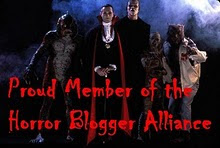Starring: Paul Lukas, Gloria Stuart, Lionel Atwilll, Edward Arnold, William Janney, Onslow Stevens, and Robert Barrat
Director: Kurt Neumann
Rating: Six of Ten Stars
On the night Irene (Stuart) turns 21, three men hoping to marry her (Janney, Lukas, and Stevens) agree to prove their bravery and worthiness of her hand by each spending successive nights in the supposedly haunted Blue Room of her castle home. Their actions seem to awaken a deadly curse that has been dormant since shortly after Irene's birth... a curse that has already claimed three lives and will soon claim more.
While this is a far more workman-like picture than "Frankenstein" or "The Invisible Man" or "Werewolf of London", I have a hard time judging how much of what seems flawed in this picture is a result of the passage of time, and how much is weakness that was present from the beginning. This kind of story has been told and retold so many times since 1933, so it could be that what was effective then is less so now.
From a story perspective, the film suffers from the mystery at its core not being much of a mystery. I had the broad strokes of the story figured out once the three suitors agreed to prove their courage by braving the possibility of death by sleeping in a cursed room. When Bad Things started happening, I was proven right... and although attempts were made at misdirection--a creepy stranger who is somehow in cahoots with the shady butler; the lord of the manor (played by Lionel Atwill) obviously trying to hide something; and a sleazy chauffeur and the nosy maid who may or may not be up to something--none really presented anything close to an alternate explanation to the mysterious events in the Blue Room. Although everything played out in a predictable fashion, the film at least unfolded at a rapid pace, and features such an excellent cast of actors that it wasn't dull. I felt the climactic chase and running gun-battle in a secret basement under the castle went on a bit too long, but otherwise I felt the pacing was spot on.
When it comes to the films cast, I feel like they all gave excellent performances. I particularly enjoyed Paul Lukas, who at the beginning of the film felt to me like a poor man's Bela Lugosi, but by the end I wanted to see what might be in store next for his character. On the other hand, I enjoyed Gloria Stuart from the beginning, but became disappointed as the film wore on. It wasn't that she gave a bad performance, she just wasn't as good as she was in "The Old Dark House", where she basically outshone all the other cast members. Here, she has less to do from the outset and she fades into the background as the movie continues. This film is a prime example of why Stuart's film career never really got off the ground; she just didn't get enough interesting roles to play.
Speaking of Paul Lukas and Gloria Stuart, as much as I liked them in the film, their characters have a very creepy relationship. As mentioned above, the film opens on a young lady's 21st birthday... and there are four men in attendance: Her father (Lionel Atwill), a would-be suitor her age, a would-be suitor five or ten years older (Oslow Stevens), and a would-be suitor old enough to be her father (Paul Lukas). It's slightly gross to think of Lukas's character wanting to marry and bed a woman less than half his age... and for her father to be sitting right there and approving of the idea. It tainted the character--who is otherwise honorable and heroic--for me, and the movie in general.
"Secret of the Blue Room" is an adequate picture that I think hasn't weathered the passage of time as well as others in the same genre. If you like "it was a dark and stormy night"-type mysteries, I think you'll enjoy it... but at the same time, you should now there are better entries in the genre out there.
















